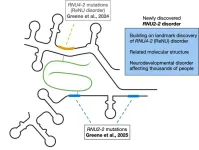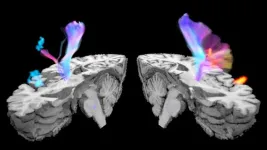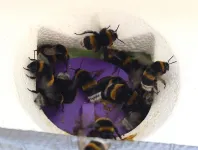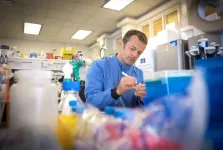(Press-News.org) New York, NY [April 10, 2025]—A seminal study from researchers at the Icahn School of Medicine at Mount Sinai and their collaborators in the United Kingdom, Belgium, Spain, the Netherlands, and Iceland has uncovered a new genetic cause of neurodevelopmental disorders (NDDs). The discovery offers both closure and hope to potentially thousands of families worldwide who have long been searching for answers.
The study, published in the April 10 online issue of Nature Genetics [DOI: 10.1038/s41588-025-02159-5], reveals that mutations in a small, previously overlooked non-coding gene called RNU2-2 are responsible for relatively common NDD. Non-coding genes are genes that don’t produce proteins but may still play critical roles in regulating cell functions.
Building on their landmark discovery of RNU4-2 / ReNU syndrome last year, the research team has identified the new, related disorder caused by mutations in the non-coding gene RNU2-2. RNU4-2 / ReNU syndrome and RNU2-2 syndromes share similarities, but patients with RNU2-2 syndrome tend to be more severely affected by epilepsy.
“Our identification of RNU2-2 mutations as a cause of NDDs is particularly notable because it cements the biological significance of a class of small non-coding genes in NDDs,” says the study's first author, Daniel Greene, PhD, Assistant Professor of Genetics and Genomic Sciences at the Icahn School of Medicine at Mount Sinai. “These mutations tend to occur spontaneously, rather than being inherited from an affected person’s parents.”
NDDs are disorders that affect the development of the brain and nervous system. They include conditions such as intellectual disability, autism spectrum disorder, and motor disorders. These NDDs, which often have a genetic basis, manifest in early childhood and can lead to lifelong challenges in learning, behavior, and communication. The current findings involve a newly discovered form of NDD.
“We know from years of experience supporting patients and families with rare genetic conditions how receiving a diagnosis like this can be life-changing and the first step on the journey to putting in place the right support and care,” says Sarah Wynn, PhD, Chief Executive Officer of Unique, an organization that provides support, information, and a voice for all those affected by rare chromosome or gene disorders.
Advances in genetic sequencing, including whole-genome sequencing of more than 50,000 individuals by Genomics England, made the development possible. This enabled the researchers to identify the cause of the novel disorder as mutations in RNU2-2, a gene once thought to be inactive. The authors also identified a separate mutation in RNU2-2 that tends to arise in unaffected individuals as they age, which may have implications for age-related conditions.
“We estimate that the prevalence of RNU2-2 disorder is approximately 20 percent that of RNU4-2 / ReNU syndrome, one of the most common monogenic types of NDD. This means there must be thousands of affected families worldwide,” says senior study author Ernest Turro, PhD, Associate Professor of Genetics and Genomic Sciences at the Icahn School of Medicine at Mount Sinai.
“With a genetic diagnosis in hand, families can connect with others in similar situations, share valuable experiences, and gain a better understanding of how to manage the condition. This discovery also makes possible further research to explore the molecular mechanisms underlying the disorder,” says Dr. Turro.
The paper is titled “Mutations in the snRNA gene RNU2-2 cause a severe neurodevelopmental disorder with prominent epilepsy.”
For the full list of authors, as well as details on funding and competing interests, please refer to the Nature Genetics paper: [DOI: 10.1038/s41588-025-02159-5].
About the Icahn School of Medicine at Mount Sinai
The Icahn School of Medicine at Mount Sinai is internationally renowned for its outstanding research, educational, and clinical care programs. It is the sole academic partner for the eight- member hospitals* of the Mount Sinai Health System, one of the largest academic health systems in the United States, providing care to New York City’s large and diverse patient population.
The Icahn School of Medicine at Mount Sinai offers highly competitive MD, PhD, MD-PhD, and master’s degree programs, with enrollment of more than 1,200 students. It has the largest graduate medical education program in the country, with more than 2,600 clinical residents and fellows training throughout the Health System. Its Graduate School of Biomedical Sciences offers 13 degree-granting programs, conducts innovative basic and translational research, and trains more than 500 postdoctoral research fellows.
Ranked 11th nationwide in National Institutes of Health (NIH) funding, the Icahn School of Medicine at Mount Sinai is among the 99th percentile in research dollars per investigator according to the Association of American Medical Colleges. More than 4,500 scientists, educators, and clinicians work within and across dozens of academic departments and multidisciplinary institutes with an emphasis on translational research and therapeutics. Through Mount Sinai Innovation Partners (MSIP), the Health System facilitates the real-world application and commercialization of medical breakthroughs made at Mount Sinai.
-------------------------------------------------------
* Mount Sinai Health System member hospitals: The Mount Sinai Hospital; Mount Sinai Beth Israel; Mount Sinai Brooklyn; Mount Sinai Morningside; Mount Sinai Queens; Mount Sinai South Nassau; Mount Sinai West; and New York Eye and Ear Infirmary of Mount Sinai.
END
Researchers have created a “metal detector” algorithm called PRRDetect to hunt down vulnerable tumours, in a development that could one day revolutionise the treatment of cancer.
In a paper published today (Thursday 10th April) in Nature Genetics, scientists funded by Cancer Research UK and the National Institute for Health and Care Research (NIHR) analysed the full DNA sequence of 4,775 tumours from seven types of cancer. Based at the University of Cambridge and NIHR Cambridge Biomedical Research Centre, they used that data from Genomics England’s 100,000 Genomes ...
A new USC-led study using functional magnetic resonance imaging (fMRI) reveals the neural mechanisms that contribute to urinary incontinence, a common condition affecting stroke survivors that has a significant impact on their quality of life.
The research, just published in Stroke, was conducted by a multidisciplinary team of urologists, neurosurgeons, and imaging experts from the Keck School of Medicine of USC, Keck Medicine of USC, the Rancho Los Amigos National Rehabilitation Center, and the Shirley Ryan Ability Lab. The team discovered significant differences in brain activity during voluntary versus involuntary bladder contractions, presenting potential pathways for targeted therapies.
Urinary ...
Using eye-tracking — a technique for recording and analysing eye movements — a team from the University of Geneva (UNIGE) has shown that individuals with multiple disabilities can improve their social and emotional skills. Although these patients are often considered ‘‘untestable’’, nine young people have undergone personalised training over a period of one year, with promising results in terms of their ability to socialise. This work opens the way to new methods of assessment and support. It is published in Acta Psychologica.
Multiple disabilities involve a combination of severe intellectual and motor impairments, resulting in profound dependence. ...
Since the pandemic, we are very aware of the power of social distancing to protect against infectious disease. But can social distancing be effective if the infectious agent isn’t a virus or bacterium, but an insect powered by a brain and wings, and with the instinct to seek out new hosts?
Now, a study published to Frontiers in Bee Science has shown that physical distance does play a leading role in protecting bumblebees against a flying insect parasite, the bumblebee wax moth Aphomia sociella. The source of the potentially lethal infection was another species, namely nearby hives of domestic honeybees.
“Here we show that infestation with bumblebee wax moths is much greater ...
Lacquers, paint, concrete—and even ketchup or orange juice: Suspensions are widespread in industry and everyday life. By a suspension, materials scientists mean a liquid in which tiny, insoluble solid particles are evenly distributed. If the concentration of particles in such a mixture is very high, phenomena can be observed that contradict our everyday understanding of a liquid. For example, these so-called non-Newtonian fluids suddenly become more viscous when a strong force acts upon them. For a brief moment, the liquid behaves like a solid.
This sudden thickening is caused by the particles present ...
Genome wide association studies (GWAS) have identified hundreds of genome regions containing thousands of genetic variants associated with asthma, but it’s still not clear which variants have an actual causal link to the disease. This “variant-to-function” gap is one of the biggest challenges to the usefulness of these genomic studies and has motivated researchers to develop new tools to make sense of GWAS results.
A new study by researchers from the University of Chicago combines genetic data and improved computational tools to look more closely ...
People should learn to meditate and hone their critical thinking skills as AI becomes more integrated into daily lives, an expert suggests.
Digital strategy expert Giulio Toscani has spoken with 150 AI experts across 50 countries to understand the challenges and opportunities around human interactions with artificial intelligence.
He argues in his new book, Augmented: prAIority to Enhance Human Judgment through Data and AI, that as humans operate largely unconsciously by design, they are inclined toward immediacy and instant rewards, often overlooking potential ...
The development of new antibiotics to treat superbugs and other bacterial infections is a global priority, with the rate of infections that cannot be treated with current antibiotics rising and presenting one of the biggest threats to human health.
In line with that, new research has shown a daily dose of epidermicin NI01 – an antibiotic compound developed by University of Plymouth spinout company Amprologix – is as effective at removing Methicillin-resistant Staphylococcus aureus (MRSA) as the current standard of care.
The results were achieved through a robust skin MRSA infection model, and those behind the research say it justifies ...
WASHINGTON (April 9, 2025) — A new study from researchers at the George Washington University has found that certain bacteria living in the nose may influence how likely someone is to get a COVID-19 infection. Published in EBioMedicine, the research reveals that certain types of nasal bacteria can affect the levels of key proteins the virus needs to enter human cells, offering new insight into why some people are more vulnerable to COVID-19 than others.
“We’ve known that the virus SARS-CoV-2 enters the body through the respiratory tract, with the nose being a key entry point. What’s new—and surprising—is that bacteria in our noses ...
A study led by the Barcelona Institute for Global Health (ISGlobal), a centre supported by the "la Caixa" Foundation, has shown that Europe has adapted better to low temperatures than to high temperatures over the last two decades. The research, carried out in collaboration with the Barcelona Supercomputing Centre (BSC) and published in The Lancet Planetary Health, shows that there has been a significant decrease in cold-related mortality risk in recent years compared to the first decade of the 2000s. There has also been a reduction in the risk of heat-related ...




